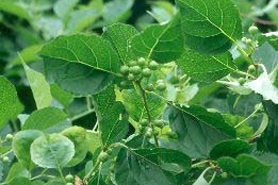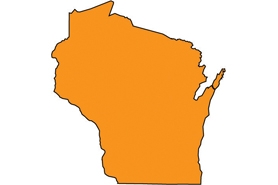Oriental bittersweet, Asian bittersweet
(Celastrus orbiculatus, Celastrus loeseneri)
Perennial, woody climbing vine. A Prolific producer of red-orange berries. Stems may reach six inches in diameter. Male and female flowers are usually borne on separate plants.
Other names for this plant include:
- Common names: Asian loeseneri bittersweet, Japanese bittersweet, round leaf bittersweet
- Scientific names: Celastrus rosthornianus var. loeseneri, C. orbiculata; C. articulatus
Classification in Wisconsin: Restricted (Oriental bittersweet), Prohibited (Asian bittersweet)
- Ecological Threat
-
- It invades forests, woodlands, fields, hedgerows and coastal areas and can grow in open sites or under a closed forest canopy.
- Oriental bittersweet proliferates and is tolerant of a wide range of habitats.
- May damage trees by girdling trunks with their woody stem, shading out the tree’s leaves or weighing down their crown, making them susceptible to wind or heavy snowfall damage.
- It is widely planted as an ornamental vine and sometimes accidentally grows when mistaken for American bittersweet.
- Identification
-
Leaves: Alternate, glossy and round with a pointing tip and shallow-toothed margins, two to five inches long.
Flowers: Small, inconspicuous, five-petaled, greenish-yellow flowers in clusters of three to seven at leaf axils. Most plants are dioecious.
Fruits & seeds: Showy, round capsules clustered in leaf axils. Green in summer, yellow-orange in fall. Split open at maturity to reveal three red-orange, fleshy fruits containing one or two seeds and dispersed by birds and small mammals.
Roots: Spreading underground roots can sprout to form new stems.
Similar species: American bittersweet (Celastrus scandens; native) has fewer, larger clusters of fruits or flowers, which are terminal rather than at leaf axils. Its leaves are less rounded and nearly twice as long as comprehensive. Hybrids of the two occur, which may make identification difficult.
- Control
- Mechanical
- Dig out or hand-pull seedlings.
- Cut the base of the vines strangling trees, allowing upper foliage to die back.
- Basal bark with triclopyr ester plus a surfactant.
- Cut stem treatment with glyphosate or triclopyr amine.
- Foliar spray with triclopyr ester or triclopyr amine plus a non-ionic surfactant.
For more information on control techniques, visit the bittersweet factsheet [exit DNR] by the University of Wisconsin-Extension.
- Resources
- Sources for content
- Czarapata, Elizabeth; Invasive Plants of the Upper Midwest: an illustrated guide to their identification and control. The University of Wisconsin Press. 2005. Pg. 45-46
- Swearingen, Jil M. Plant Conservation Alliance, Alien Plant Working Group. Least Wanted: Oriental bittersweet [exit DNR]. Last updated June 2006.



